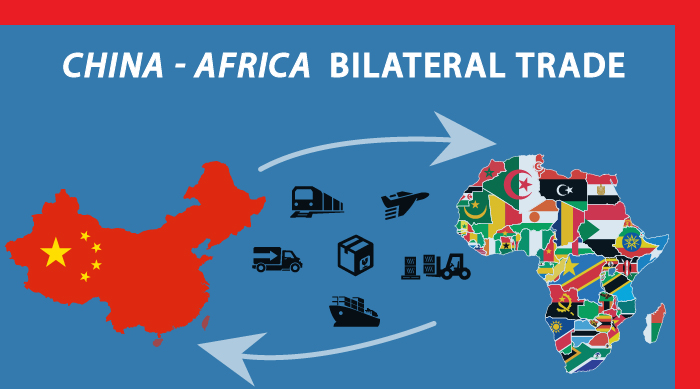International trade is a crucial economic activity that drives global growth and development. However, trade imbalances can arise when two countries exchange goods and services at different rates. One such example is the asymmetric trade relationship between China and South Africa, which has sparked considerable interest and concern among policymakers and economists.

Image: news.cgtn.com
This article aims to delve into the complex dynamics of asymmetric trade between China and South Africa, exploring its historical roots, underlying causes, and potential consequences. We will also examine the latest trends and developments, offering insights from experts and valuable tips for understanding this important economic phenomenon.
Understanding Asymmetric Trade: A Profound Imbalance
Asymmetric trade occurs when one country consistently exports more goods and services to another country than it imports from it. This imbalance creates a trade deficit for the importing country and a trade surplus for the exporting country.
In the case of China and South Africa, the trade relationship has been asymmetric for several decades, with China accounting for the vast majority of exports to South Africa. This asymmetry has raised concerns about South Africa’s economic dependence on China, as well as its impact on local industries and job creation.
Causes of Asymmetric Trade: Complex Factors at Play
The causes of asymmetric trade between China and South Africa are multifaceted and include both economic and political factors. One key factor is China’s low labor costs and extensive manufacturing capabilities, which allow it to produce goods at a much lower cost than many other countries.
Another factor is South Africa’s reliance on raw material exports, particularly minerals and agricultural products, which often fetch lower prices on the international market compared to finished goods. Moreover, South Africa’s industrial base is relatively weak, making it less competitive in the global manufacturing sector.
Consequences of Asymmetric Trade: Both Opportunities and Challenges
Asymmetric trade can have both positive and negative consequences for the countries involved. On the positive side, it can provide the importing country with access to a wider range of goods and services at lower prices. In the case of South Africa, China’s low-cost exports have helped to drive down consumer prices and improve living standards.
However, asymmetric trade can also lead to negative consequences. The importing country may become overly dependent on the exporting country, resulting in a loss of domestic industries and jobs. This can also lead to a surge in imports and a decline in exports, further exacerbating the trade imbalance.

Image: www.africanleadershipmagazine.co.uk
Latest Trends and Expert Insights: Navigating a Shifting Landscape
The asymmetric trade relationship between China and South Africa is evolving, and the latest trends and expert insights shed light on this dynamic. One notable trend is China’s increasing investment in South Africa, particularly in infrastructure and energy projects. This investment has the potential to create jobs and stimulate economic growth in South Africa.
According to experts, the key to managing asymmetric trade lies in diversification and value addition. South Africa needs to diversify its exports beyond raw materials and focus on value-added products, such as processed goods and services. This will help to reduce its dependence on China and boost its economic competitiveness.
Tips for Understanding Asymmetric Trade: Empowering Readers
To fully grasp the complexities of asymmetric trade, it is essential to understand the underlying factors and their potential consequences. Here are some tips for empowering readers:
**Read widely:** Consult reputable sources, such as international organizations, government reports, and academic journals, to gather a comprehensive understanding of the topic.
**Analyze data:** Examine trade statistics and economic indicators to observe patterns and trends in asymmetric trade relationships.
**Seek expert opinions:** Engage with economists and policy experts to gain insights into the causes and consequences of asymmetric trade.
FAQs: Demystifying Asymmetric Trade
Q: Is the asymmetric trade relationship between China and South Africa a permanent state of affairs?
A: No, it is not permanent. Trade relationships can evolve over time as economic conditions and government policies change.
Q: What can South Africa do to address the trade imbalance with China?
A: South Africa can diversify its exports, invest in value-added products, and promote trade with other countries.
Q: What are the potential benefits of South Africa reducing its trade deficit with China?
A: Reduced trade deficit can lead to job creation, increased economic competitiveness, and a more balanced economy.
Asymmetric Trade Between China And South Africa
Conclusion
Asymmetric trade between China and South Africa is a complex issue with both positive and negative implications. Understanding the causes and consequences of this trade imbalance is crucial for policymakers and economists to devise strategies to harness its potential benefits while mitigating its risks. By fostering diversification, encouraging value addition, and examining expert insights, we can empower stakeholders to navigate the complexities of asymmetric trade and create economic prosperity for all.
Are you interested in learning more about asymmetric trade between China and South Africa? Share your thoughts and questions in the comments below or reach out for further discussion. Your insights can contribute to a deeper understanding of this important topic.






